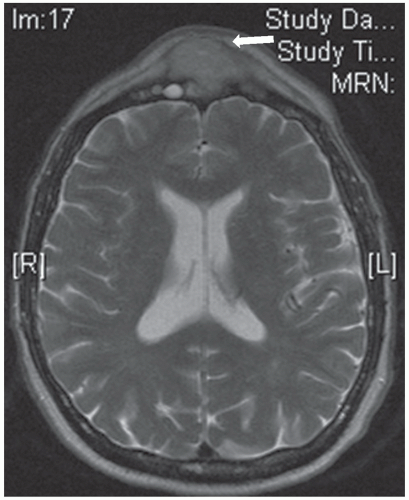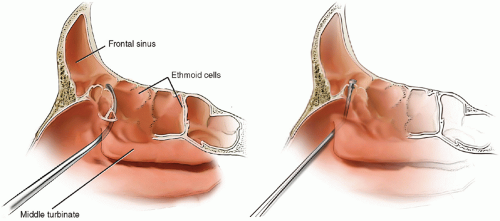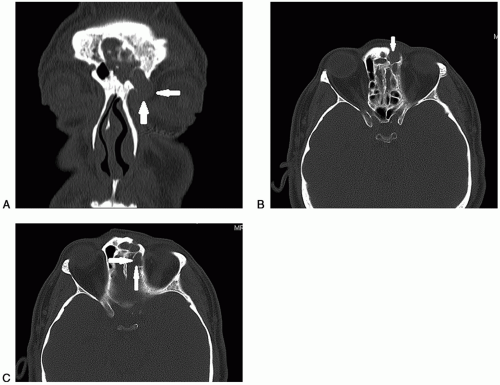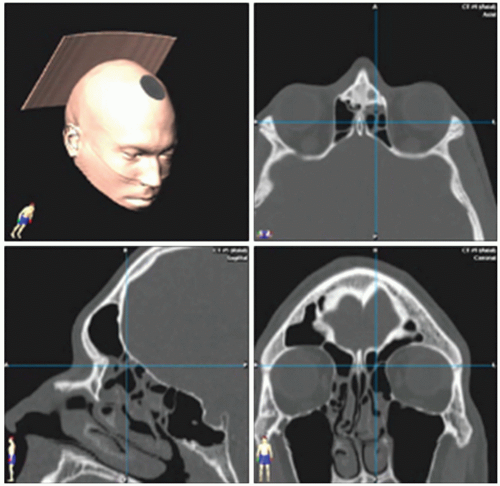Endoscopic Frontal Sinusotomy (Draf 2A Procedure)
David W. Kennedy
INTRODUCTION
Surgery of the frontal sinus remains the most difficult area within the management of chronic rhinosinusitis (CRS). This is evidenced by the variety of approaches to the problem, which have been proposed over the years. Endonasal approaches were originally proposed by Schaeffer, Halle, Moser, and others in the early part of the 20th century. However, these were largely blind approaches and associated with significant complications. Accordingly, for much of the 20th century, the focus was on external approaches to frontal sinus disease, such as frontal sinus collapse (Riedel procedure), osteoplastic frontal sinusotomy, and frontal sinus obliteration. With the advent of endoscopic techniques in the latter part of the 20th century, interest was renewed in endonasal approaches to frontal sinus disease and frontal sinus mucoceles. Early approaches tended to be associated with significant trauma to the frontal recess, loss of mucosa, and a significant incidence of stenosis. However, with the advent of delicate through-cutting angled instrumentation, curved microdebriders, triplanar imaging, computer-assisted surgical navigation, and delicate malleable probes for the intraoperative identification of the frontal sinus drainage pathway, very delicate atraumatic and effective frontal sinus drainage can now be achieved endoscopically with a minimally invasive (Draf 2a) procedure and a low risk of stenosis of the frontal sinus. Stammberger has called this procedure, somewhat aptly, “uncapping the egg.” The concept here is that a diseased and enlarged ethmoid infundibulum, ethmoid cell, or agger nasi cell that blocks the frontal sinus drainage pathway can be considered somewhat similar to an eggshell inside in an inverted egg cup (frontal recess). In order to reestablish drainage, it is necessary to fracture and remove the bone of the expanded cell (eggshell) away from the surrounding mucosal-covered bone (egg cup) in a minimally traumatic fashion (Fig. 17.1).
While tumors of the frontal sinus typically require an extended frontal sinus procedure, the vast majority of patients with CRS involving the frontal sinus and frontal sinus mucoceles even with extensive intraorbital and intracranial involvement, can be operated through a Draf 2a procedure (Fig. 17.2). Although when I initially suggested approaching mucoceles endoscopically with this approach it was received with significant skepticism and controversy, long-term success has now been well documented. Patients with CRS presenting for endoscopic frontal sinusotomy typically have associated disease in other sinuses, in particular the ethmoid sinus, and therefore most frequently are best addressed with a surgical approach rather than just a balloon dilatation procedure. Additionally, removal of osteitic bone fragments is an important goal in the prevention of persistent inflammation and renewed stenosis.
The success of a Draf 2a approach depends significantly upon the surgeon’s experience, the availability of appropriate minimally invasive instrumentation, and the ability of the surgeon to adequately conceptualize the 3-D anatomy of the frontal sinus drainage pathway prior to surgical intervention. It also requires endoscopic follow-up because should stenosis occur, mucocele formation often remains asymptomatic for between 15 and 20 years. Additionally, as with other surgery for CRS, the surgery itself is primarily adjunctive to medical management, and endoscopic follow-up provides the necessary basis for such therapy, which in some cases will be prolonged.
HISTORY
Patients with CRS and frontal sinus involvement will typically present with pressure or discomfort in the forehead over the affected sinus. Severe headaches are not typical of CRS but may occur in acute sinusitis, in the early stages of frontal sinus obstruction, or in a situation of a threatened intracranial complication. While patients with early frontal sinus obstruction may develop barosinusitis with severe pain on aircraft descent or with scuba diving, in my experience complaints of headache or pressure associated with weather change are more likely related to vascular headaches. Patients with inflammatory
frontal sinusitis may also present with forehead swelling (Pott puffy tumor), proptosis, displacement of the globe, or diplopia (Fig. 17.3). Although patients with CRS are unlikely to develop intracranial complications, patients with severe acute frontal sinusitis, particularly young adolescent males, are at significantly greater risk of developing meningitis or other intracranial complications. Patients who are candidates for a Draf 2a procedure may or may not have had prior ethmoidectomy or frontal sinusotomy. In many cases, even when a prior frontal sinusotomy has been performed, there are residual osteitic bony partitions, and meticulous removal of these may resolve the frontal sinus disease without the necessity of a more extended frontal sinus procedure.
frontal sinusitis may also present with forehead swelling (Pott puffy tumor), proptosis, displacement of the globe, or diplopia (Fig. 17.3). Although patients with CRS are unlikely to develop intracranial complications, patients with severe acute frontal sinusitis, particularly young adolescent males, are at significantly greater risk of developing meningitis or other intracranial complications. Patients who are candidates for a Draf 2a procedure may or may not have had prior ethmoidectomy or frontal sinusotomy. In many cases, even when a prior frontal sinusotomy has been performed, there are residual osteitic bony partitions, and meticulous removal of these may resolve the frontal sinus disease without the necessity of a more extended frontal sinus procedure.
 FIGURE 17.3 Axial CT scan in a patient with a Pott puffy tumor. Note the forehead swelling and the erosion of the anterior table of the frontal sinus. |
In taking the patient’s history, particular attention should be paid to the past history of rhinosinusitis, whether it has been adequately managed medically, and potential environmental and allergic triggers. The character of any forehead discomfort should be identified, along with precipitating factors and therapies providing relief. In all cases, except those with threatened or active intracranial complications, medical therapy is indicated prior to surgical intervention.
PHYSICAL EXAMINATION
On physical examination of the head and neck area, the forehead is examined for any evidence of erythema or swelling. The eyes should be examined for any evidence of globe displacement or of any limitation of extraocular movements. The frontal sinus should be palpated and percussed and any evidence of pain or tenderness noted. In particular, in acute frontal sinusitis tenderness may be noted in the medial supraorbital area. Although, in the absence of knowledge regarding frontal sinus pneumatization, transillumination is not diagnostic of frontal sinus disease, decreased transillumination on the side of frontal sinus discomfort can provide a useful guide for further evaluation. Additionally, when the patient is known to have previously had good frontal sinus pneumatization, absence of transillumination is diagnostic of frontal sinus disease. Furthermore, good frontal sinus transillumination excludes diffuse frontal sinus mucosal disease. However, good transillumination does not exclude symptoms of frontal sinus origin, because inflammation in the frontal recess and its partial obstruction cannot be excluded.
Endoscopic intranasal examination with an angled telescope is critical. Medial displacement of the uncinate process may be observed with subsequent obstruction of the frontal sinus drainage pathway. In polypoid disease, small polyps may be seen superiorly in the middle meatus adjacent to the frontal sinus outflow tract. Following decongestion, purulent exudate may be seen in the area of the frontal recess, which can be cultured under direct endoscopic visualization. Mass lesions may also sometimes be identified, with medial
displacement of the anterior attachment of the middle turbinate. During the endoscopic evaluation, the position of the nasal septum, especially in the region of the bony cartilaginous junction, is noted. A deviation in this area may require a septoplasty at the time of the surgical intervention. In general, it should be possible to easily introduce a 4-mm zero-degree telescope to the anterior attachment of the middle turbinate if septoplasty is not required.
displacement of the anterior attachment of the middle turbinate. During the endoscopic evaluation, the position of the nasal septum, especially in the region of the bony cartilaginous junction, is noted. A deviation in this area may require a septoplasty at the time of the surgical intervention. In general, it should be possible to easily introduce a 4-mm zero-degree telescope to the anterior attachment of the middle turbinate if septoplasty is not required.
Computed tomography with multiplanar images is required prior to surgical intervention, and this is typically performed with a technique adequate for intraoperative surgical computer-assisted guidance (Fig. 17.4). Particular attention is paid to the anatomy of the frontal recess, the degree of pneumatization of the frontal sinus itself, the anterior ethmoid neurovascular bundle, the skull base, and the medial orbital wall.
INDICATIONS
Acute frontal sinusitis, which is not responding to medical management or where there is impending or actual complications. In some of these cases, a frontal sinus trephine at the time of endoscopic drainage may also be indicated.
CRS with involvement of the frontal recess with symptoms that have not responded adequately to appropriate medical therapy.
Mucoceles of the frontal sinus with or without erosion intracranially or intraorbitally.
Allergic fungal sinusitis. Even in the absence of marked frontal sinus involvement, these patients typically require a very complete removal of the ethmoid bony partitions including those within the area of the frontal recess.
Neoplasms. Although in most cases of tumors involving the frontal sinus, an extended frontal sinusotomy, such as a midline drainage procedure or Draf 3 procedure, will be required to ensure complete removal of a tumor involving the frontal sinus, in some cases, it may be possible to remove the lesion extending into the frontal sinus with a Draf 2a procedure. A Draf 2a procedure is also performed when skull base surgery in the ethmoid area might result in scarring and frontal sinus obstruction.
Stay updated, free articles. Join our Telegram channel

Full access? Get Clinical Tree





